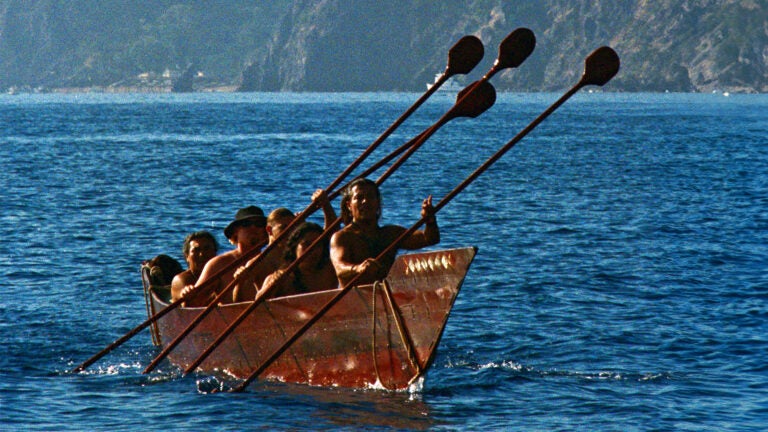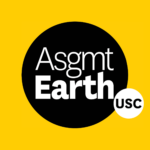
Ancient canoe revival highlights Indigenous sustainability practices and ocean conservation
The Tongva tribe, the original inhabitants of Los Angeles and Orange Counties and the Southern Channel Islands off California’s coast, faced cultural erasure during colonial times as Spanish settlers moved into the area. The Tongva lost many of their traditions, including sustainable living practices that could be valuable today.
A grant from the Library of Congress to researchers at the USC Dornsife College of Letters, Arts and Sciences aims to broaden understanding of the tribe’s sustainable practices while restoring knowledge and understanding of the Tongva’s ancient customs and culture.
Why it matters: Preserving Native American traditions is key to understanding California history, and raising awareness of Indigenous ecological knowledge could help safeguard oceans and foster sustainability, especially as the planet confronts climate change.
In her words: “This is an effort to reclaim a chapter of California’s history that has been lost,” said archaeologist Lynn Dodd, professor of religion and spatial sciences at USC Dornsife. “It’s like we’re breathing life back into a tradition.”
Dodd secured a $50,000 Library of Congress grant to fund the collaboration between USC scholars and members of the Ti’at Society, which was established to restore a traditional Tongva canoe called a “ti’at” and revive their ancient maritime practices.
- The grant enabled the team to research Tongva artifacts at the Smithsonian Museum of Natural History and National Museum of the American Indian in Washington, D.C.
- USC Libraries, collaborating with the Ti’at Society, will create a digitized archive of Tongva photos, documents, knowledge and memories for the American Folklife Center.
- The Ti’at Society will launch an educational program with workshops on Tongva maritime traditions and boat building at AltaSea, an ocean research center located in the Port of Los Angeles.
Cindi Alvitre, co-founder of the Ti’at Society and professor of American Indian studies at California State University, Long Beach, said the grant will improve understanding of the interplay between climate change, urban development and Indigenous cultures, which is “key to reviving our heritage and preserving the future of the ocean.”
Zoom in: The Tongva, who inhabited Catalina Island for millennia, relied on ti’ats — plank canoes that stretched 20 feet and more — to obtain food from the ocean and conduct trade along the California coast.
- The Spanish conquest beginning in 1769 brought an end to ti’at construction for centuries.
What else? The grant supported moving the first ti’at built since the 1800s from storage to AltaSea.
- On April 6, the Ti’at Society — comprising members of the Tongva, Chumash and other tribal communities — is hosting an event at AltaSea to celebrate the arrival of the ti’at and honor the Tongva people and their seafaring heritage and ocean stewardship.
- The event will include hands-on workshops, demonstrations of traditional knowledge of sustainable plant use, and an exhibit of images and videos showing the ti’at’s construction.
The backstory: Tongva descendant Alvitre said she was inspired by a vision to establish the Ti’at Society and collaborate with Indigenous boat-builders to construct a full-size, ocean-going ti’at.
- The last Chumash boat builder, Fernando Librado (also known as Kitsepawit), showed his craft to anthropologist John Peabody Harrington in the early 20th century.
- Anthropologist Travis Hudson of the Santa Barbara Natural History Museum later used Harrington’s notes to rebuild a Chumash plank canoe in the 1970s.
- The Chumash canoe helped guide the Ti’at Society’s construction beginning in the late 1980s.
- Named Moomat Ahiko (“Breath of the Ocean”), the society’s ti’at was completed in 1994.
The boat’s construction reflects the diversity of California’s native landscape, using traditional materials like redwood for the planks from the Karuk Tribe along the Klamath River, plant fiber for cords, and naturally occurring tar called asphaltum for adhesion and waterproofing.
What to watch: The partnership between AltaSea and the Tongva connects the Indigenous practice of kelp forest cultivation to the research USC Dornsife Professor of Biological Sciences Sergey Nuzhdin conducts at his AltaSea-based aquaculture lab.
- “Uniting social and natural scientists with local Indigenous people allows us to integrate traditional ecological knowledge of the kelp ecosystem with sustainability research and education,” Nuzhdin said.
- Nuzhdin’s team has already begun collaborating with Indigenous people in California and Alaska to restore the endangered North Sea palm kelp, a vital food and medicine source for them.